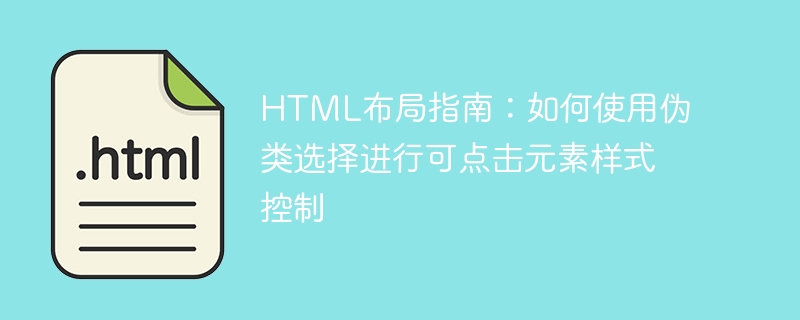

HTML Layout Guide: How to use pseudo-class selection for clickable element style control
Introduction:
In web design, selectors are an important Technique for controlling the styling of elements. In addition to common selectors, such as tag selectors, class selectors and ID selectors, there is also a powerful selector - pseudo-class selector. Pseudo-class selectors can select elements and apply different styles to them based on their state or position. Among them, you can use pseudo-class selectors to control the style of clickable elements to improve user experience and page interactivity. This article will introduce in detail how to use pseudo-class selectors to implement style control of clickable elements and provide specific code examples.
1. The concept and basic usage of pseudo-class selectors:
Pseudo-class selectors are a special selector in CSS, used to select elements with specific status or characteristics. Common pseudo-class selectors include:hover (mouse hover), :active (activated when clicked), :visited (visited link), etc. Using pseudo-class selectors can more flexibly control the style of elements and improve user experience.
Take the :hover pseudo-class selector as an example. When the mouse hovers over an element, you can apply specific styles to the element, such as changing the font color, background color, etc. The basic syntax for using the :hover pseudo-class selector is as follows:
selector:hover {
property: value;
}Among them, selector is the name of the selector, property is the style attribute that needs to be changed, and value is the value of the style attribute.
2. How to use pseudo-class selectors to control the style of clickable elements:
In actual web design, there are many clickable elements, such as buttons, links, etc. By using pseudo-class selectors, you can add specific styles to these clickable elements to increase visual feedback when clicking and improve the user's interactive experience.
Add hover effects to buttons:
Buttons are common clickable elements in web pages. We add hover effects to buttons by using the :hover pseudo-class selector. The specific code is as follows:
button:hover {
background-color: #f9f9f9;
color: #ff0000;
border: 2px solid #ff0000;
}When the mouse hovers over the button, the background color of the button will change to #f9f9f9, the font color will change to #ff0000, and the border will change to red.
Add click effects to links:
Links are elements that point to other pages or locations. By using the :visited pseudo-class selector to add click effects to links, you can increase the user's response to clicks. Perception of status. The specific code is as follows:
a:visited {
color: #00ff00;
text-decoration: underline;
}When the user clicks on the link and visits it, the font color of the link will change to #00ff00 and the underline will appear.
Add click effects to pictures:
In some cases, we need to add click effects to pictures to facilitate users to zoom in or jump to the picture. By using the :active pseudo-class selector, you can add click effects to images. The specific code is as follows:
img:active {
transform: scale(1.2);
}When the user clicks on the image, the image will be enlarged 1.2 times.
3. Summary:
The pseudo-class selector is a powerful selector. By using the pseudo-class selector, you can control the style of clickable elements and improve the user experience. Experience and page interactivity. This article introduces the basic concepts and usage of pseudo-class selectors and provides specific code examples. In the actual web design process, we can flexibly use pseudo-class selectors to control the style of elements according to needs. Through in-depth study and practice, we can become more proficient in using pseudo-class selectors and provide users with a better page interaction experience.
The above is the detailed content of HTML Layout Guide: How to use pseudo-class selection for clickable element style control. For more information, please follow other related articles on the PHP Chinese website!




